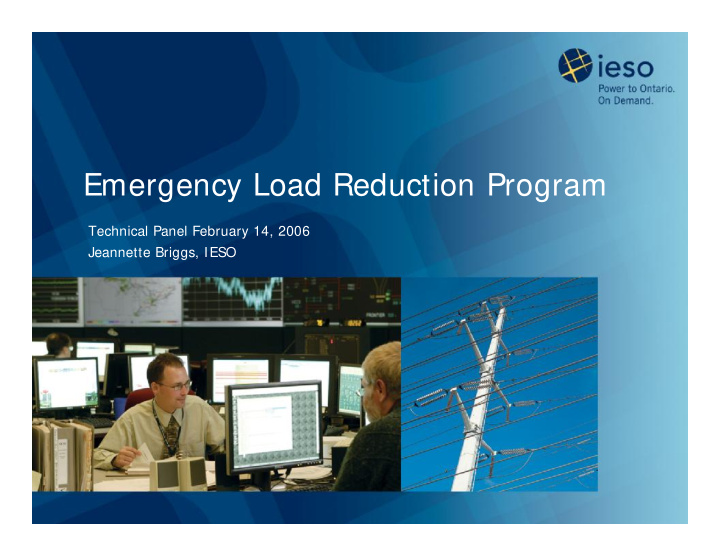



Emergency Load Reduction Program Technical Panel February 14, 2006 Jeannette Briggs, IESO
Background and Objectives • Why Now? • Program Potential • Emergency Load Reduction Program (ELRP) Design
Why Now? • Tight demand/ supply conditions during 2005 – 12 days of public appeals – Three occasions when we implemented five percent voltage reductions – Numerous other occasions where we took other emergency control actions to preserve the reliability of the power system • This program is one of several initiatives that we are taking before summer 2006 to avoid or limit the need for these emergency control actions to maintain reliability
ELRP Potential • Implementation before other emergency control actions • Allowing loads a greater opportunity to provide reliability support under stressed system conditions • Reduced reliance on other emergency control actions • Increased demand response involvement (such as aggregated response, back up generation etc.)
ELRP Design • Eligibility • Demand Response Criteria • Notification and Activation • Payment
Who is Eligible to Participate? • Open Participation; this is a voluntary program: – Available to both interruptible loads and emergency backup generation; must be MP • Should be of interest to: – Wholesale market participant loads – Individual embedded loads – Aggregators • Minimum 1 MW • Measurable and verifiable (M&V) • Not concurrently part of any other program
When and What? • Can be used on business days 8:00 a.m. – 8:00 p.m. • Reduction lasting 2, 3 or 4 hours • One activation per day • Eligible participants that want to offer the service on a given day will submit an ELRP form once we notify them of our need • Submission of form represents a commitment by MP, at direction of IESO, to reduce load by amount specified and in hours specified
Notification and Activation Notification • Electronic notification of our needs can be either day- ahead or day at hand • Day-ahead: we notify by 4:00 p.m., those wishing to supply submit the form by 6:45 a.m. next day • Day at hand – we notify by 9:00 a.m.; those wishing to supply must submit the form by 10:45 a.m. Activation • You must reduce when activated if you have submitted the demand reduction form • Electronic activation will be a least 1 hour prior to required reduction hour
Payments Standby payment: • For committed hourly MW reduction capability • $15/ MW per hour • Stops once activation occurs • On preliminary settlement statement for last day of month Activation payment (subject to M&V): • The greater of HOEP or – $400/ MWh for 2 hours of consecutive reduction, or – $500/ MWh for 3 hours of consecutive reduction, or – $600/ MWh for 4 hours of consecutive reduction. – Payment post M&V submission
How Often Will It Be Used? • Reliability needs are highly unpredictable as they are dependent on a many variables • Without knowing how often the program will be used, it is difficult to forecast an income stream • As a proxy, we can compare standby and activation payments that would have taken place in the summers of 2004 and 2005
Payment Example Using 2004 and 2005 2004 2005 Notifications 1 12 One 4 hour event One 3 hour event (Activation Hr 17) (Activation Hr 13) Activations Two 4 hour events (Activation Hr 13 and Hr 16) Payment/MW $2,535.00 $8,130.00 (Notification & Activation combined)
Going Forward • Information available at : http:/ / www.ieso.ca/ imoweb/ consult/ consult_drrp.asp • Board Meeting, February 3, 2006 directed IESO Management to develop and implement for use in the summer, 2006 the Emergency Load Reduction Program • Targeting April 7th Board approval of the rules • First Quarter 2006- Market Rules to Technical Panel • Second Quarter 2006 – Consultation with stakeholders on Market Manual
Recommend
More recommend